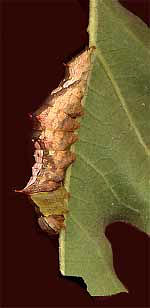 Many caterpillars' usual designs and structures can be explained by their need to stay "invisible" to caterpillar-eating enemies, particularly birds. For example, at the right you see the caterpillar of the Morning Glory Prominent, Shizura ipomoeae, a brownish moth found through most of the US, at rest on a Black Oak leaf in late October.
Many caterpillars' usual designs and structures can be explained by their need to stay "invisible" to caterpillar-eating enemies, particularly birds. For example, at the right you see the caterpillar of the Morning Glory Prominent, Shizura ipomoeae, a brownish moth found through most of the US, at rest on a Black Oak leaf in late October.
At first this caterpillar went unnoticed because it looked like a brown, curled-up edge of a beat-up, tattered leaf about to fall to the ground. In other words, the caterpillar was camouflaged! In the picture, the caterpillar's head is at the bottom, then right above the head there's a green area. Old, ready-to-fall oak leaves often bear both brown and green splotches.
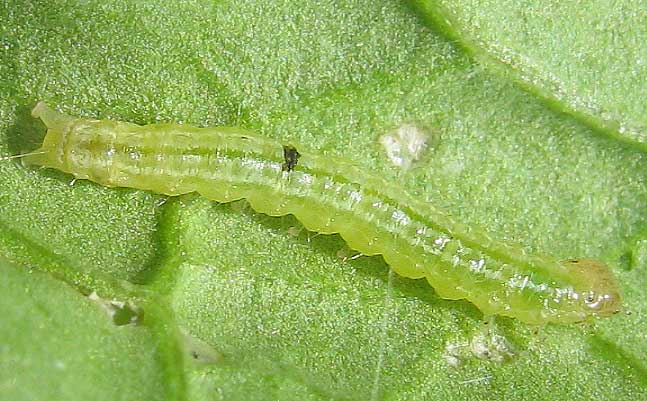
Maybe the simplest form of caterpillar camouflage is shown by the Hawaiian Beet Webworm, Spoladea recurvalis, maybe hard to see at the left. Being green like the leaf it's chewing on isn't a fancy camouflage, but when combined with the behavior of staying mostly on the hidden underside of the leaves it's eating, it works well enough.
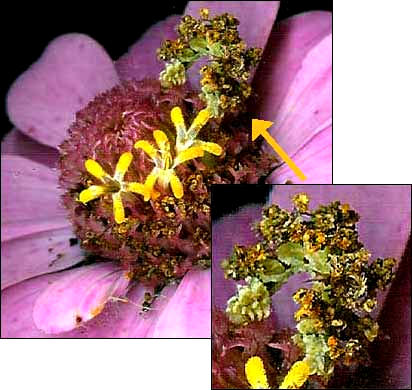
At the right you see -- or maybe you don't see -- camouflage carried to an extreme. The inset at the picture's lower right shows a close-up of a camouflaged caterpillar. Can you see how the caterpillar is curved into an arch, with six white legs at the bottom of the arch's left side?
What's amazing here is that this caterpillar, the Wavy-lined Emerald caterpillar, Synchlora aerata, is camouflaged with pieces of the Zinnia blossom it is eating. The grainy, orange-yellow items sticking to the caterpillar's back are anthers removed from the Zinnia's disk flower. You can see some of them in the larger picture. Wavy-lined Emerald caterpillars eat many kinds of flowers, not just Zinnias, so their camouflage covering may consist of many things other than Zinnia anthers, providing the caterpillar with many possible colors and shapes, but always looking amazingly like the flower it is eating! This species isn't particularly rare over its area of distribution, so be on the lookout for it.
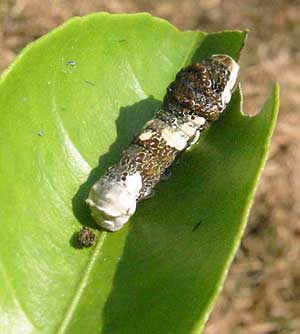
What do you see at the left? No, not it's not a messy bird-dropping, but a caterpillar that looks like a bird dropping. It even goes so far as having white patches on it simulating the white paste coating many bird droppings, which is mostly uric acid, as explained on our famous Bird Excretion Page. Well you can see why a caterpillar might benefit from looking like bird poop: Birds don't want to eat other birds' excrement.
Of course caterpillars don't think out any of this camouflage business. Millions of years of evolution simply caused caterpillars to have these particular shapes, colors and behaviors. For, throughout caterpillar history, the less birds and other predators could see them, the more they survived to produce adults, who produced more eggs for future caterpillars to hatch from. With time, the combinations of colors and structures were refined, until we have the amazing camouflage we can see in them today.
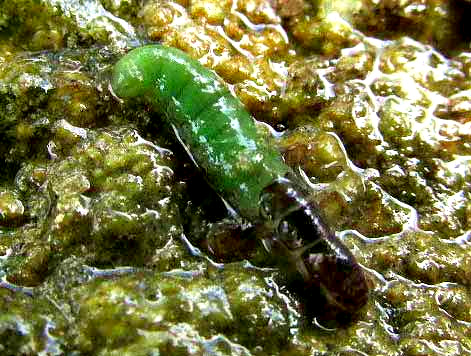
An interesting twist to the whole camouflaged-caterpillar matter is shown at the right. On a wet, slimy, algae-covered stream bank, from a distance it looks like a black ant pulling home a caterpillar it's caught, to be eaten in the ant nest. That's a common enough drama to see. However, in this case the ant just consists of dark splotches at the thing's bottom. And the thing itself isn't a caterpillar at all, but rather a caddisfly larva whose camouflage, at least to some observers, causes it to look like a caterpillar pulled by an ant. A bird may want the "caterpillar," but may be wary of fighting an ant for it, particularly a wet one.
Or, is all this just one's imagination? The world of camouflage is one of doubt and confusion, and when you see something like this, it's hard to be absolutely sure what's going on. But, that's the way it is with very much of Nature.
